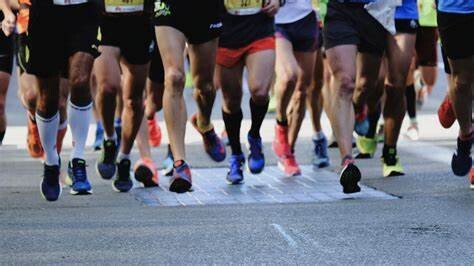Running News Daily
Running News Daily is edited by Bob Anderson. Send your news items to bob@mybestruns.com Advertising opportunities available. Train the Kenyan Way at KATA Kenya and Portugal owned and operated by Bob Anderson. Be sure to catch our movie A Long Run the movie KATA Running Camps and KATA Potato Farms - 31 now open in Kenya! https://kata.ke/
Index to Daily Posts · Sign Up For Updates · Run The World Feed
Run the tangents to crush your race-day goals
Running faster isn’t just about building strength and endurance—sometimes, it’s about getting smart with your strategy. One often overlooked technique is running the tangents. By taking the shortest possible race route, you can shave off precious seconds and even minutes from your time. Here’s how you can master the art of running tangents and blast to a race-day PB.
Maximize efficiency, minimize extra mileage on race day with this technique
What are tangents?

Running the tangents simply means taking the shortest path around a course, and is derived from a basic principle: the shortest distance between two points is a straight line. Imagine a race course filled with curves and corners—instead of sticking to the center of the road or weaving back and forth, running tangents involves cutting straight lines from one apex to another. By doing this, you minimize the distance you run and maximize your efficiency.
For instance, if you’re running a race with a lot of turns, you’d be amazed how much less mileage you’ll have to run if you stick to the inside of each curve, rather than the outside. Consider a typical marathon with numerous turns—by consistently choosing the shortest path, you might easily cut out hundreds of unnecessary meters.

It’s a strategy elite runners use to their advantage, and you can, too—while it sounds intuitive, you probably aren’t paying enough attention to the concept. Over the course of a marathon, these small adjustments can add up to save you significant time and energy.
Do it like the pros
A USATF-certified marathon course is measured precisely, to the inch–and it’s not measured from the middle of the road: “You might envision the shortest possible route as a string, stretched tightly along the course so that it comes within one foot of all corners, straight through S-turns, and diagonally between corners when crossing a street,” USATF explains on their website. When you run along this invisible line, you are running the tangents.
For races with qualification standards where even seconds count (like the Boston Marathon, for example), running the tangents can be key to hitting or missing the race of your dreams.
Practice and preparation
Running tangents effectively takes some practice and a bit of foresight. Plan your route before race day, studying the course map and identifying where the turns are. Visualizing your route in advance can help you plan where to cut the tangents. Incorporate tangent running into your regular training runs—on your next run, practice cutting the corners efficiently to get a feel for the technique.
Race day mastery
During the race, keep an eye on the road ahead. Look for the shortest line through each curve, and adjust your position accordingly. Ensure that you’re not cutting corners illegally by staying within the designated course boundaries—being safe and following the rules comes first. It’s a good idea to check over your shoulder to make sure no one is bearing down on you before changing your position, and start gradually moving to the inside of an upcoming curve a few dozen metres ahead of time.
by Keeley Milne
Login to leave a comment




